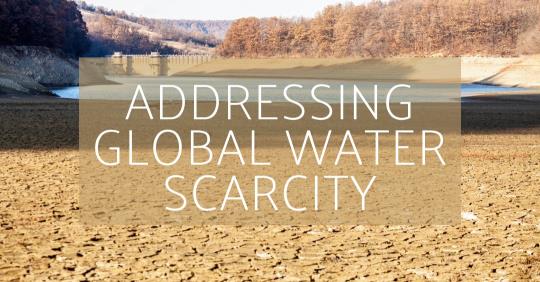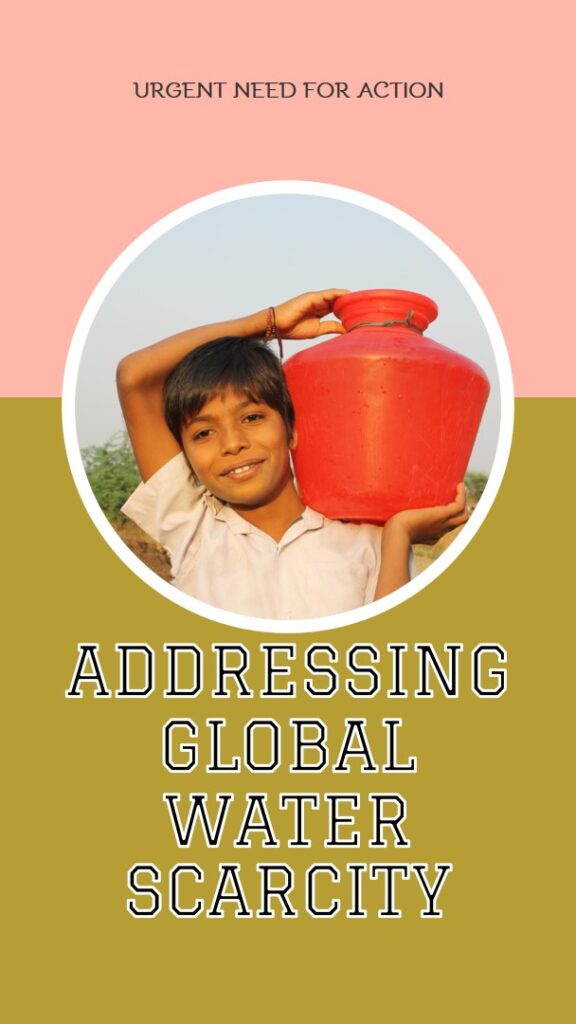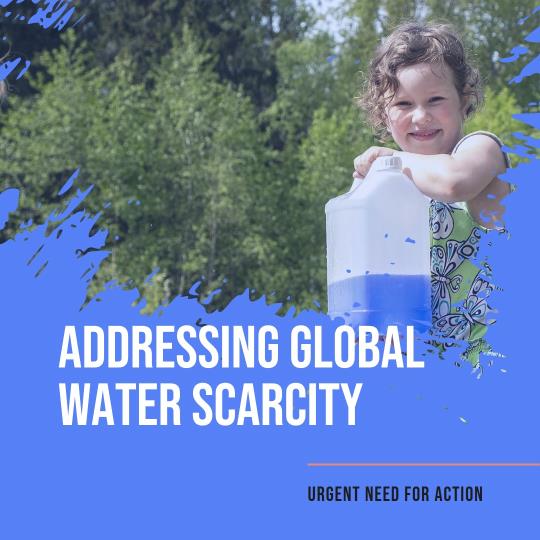Table of Contents
ToggleBeyond the Drips: Navigating the Depths of Global Water Scarcity

Water, the cradle of life, is facing an unprecedented threat on a global scale—water scarcity. As we embark on this profound exploration, we will meticulously delve into the intricate web of the root causes, the pervasive reality of water scarcity around the world, and the compelling imperative for sustainable solutions. Join us on this compelling journey to not only comprehend the gravity of the global water crisis but also to explore the undeniable facts surrounding water scarcity in the world, envisioning a future where water is not just a necessity but an accessible abundance for every living being on this planet.
auses of the Global Water Crisis:
One of the primary contributors to the looming global water crisis is undeniably climate change. The altering climate patterns intensify droughts, leading to unpredictable precipitation and further exacerbating water scarcity in the world. The rising global temperatures contribute to the melting of glaciers, affecting the seasonal water supply.
As the global population continues its unprecedented surge, the demand for water for various purposes, including agriculture, industry, and daily consumption, has skyrocketed. This surge in demand, often outstripping the available supply, is a key factor in the water shortage in the world.
Poor water management practices significantly contribute to the depletion of water sources. Inefficient water use, lack of proper infrastructure, and unsustainable practices compound the challenges associated with water scarcity. Furthermore, pollution, stemming from industrial discharges, agricultural runoff, and untreated sewage, not only diminishes water quality but also exacerbates the complexities of water scarcity problems.


Extent of Water Scarcity:
Currently, over 2 billion people worldwide find themselves residing in areas facing high water stress. In these regions, the demand for water far exceeds the available supply, painting a grim picture of the escalating water scarcity worldwide.
According to the World Resources Institute, 17 countries, including India, Qatar, and Israel, are grappling with extremely high worldwide water crisis. The repercussions of this crisis extend beyond borders, making it a global challenge that necessitates collaborative solutions.
Predictions from the United Nations are equally alarming, forecasting that nearly two-thirds of the global population could be living under “water-stressed” conditions by 2025. This underscores the urgency of addressing the escalating water shortage problems.

Is Water Scarcity Increasing? Undoubtedly, the global water crisis is intensifying, fueled by a combination of factors including population growth, climate change, and unsustainable water use. Previously considered water-secure regions are now grappling with the unexpected and severe implications of water shortage around the world.
5 Facts About Water Scarcity:
- Human Impact: Over 700 million people in 43 countries currently endure the harsh reality of water scarcity worldwide.
- Agricultural Strain: Agriculture’s voracious consumption, accounting for about 70% of the world’s freshwater, is putting immense pressure on water resources and contributing significantly to the global water crisis.
- Economic Consequences: The economic toll of water scarcity is projected to be substantial, with some regions expected to lose up to 6% of their GDP by 2050. This impact ripples through industries, livelihoods, and overall economic stability.
- Social Ramifications: Water scarcity has the potential to instigate social unrest and conflicts over water resources, further exacerbating existing geopolitical tensions.
- Environmental Toll: Ecosystems worldwide are suffering as water scarcity contributes to the depletion of wetlands, degradation of water quality, and loss of biodiversity, underscoring the intricate connection between water scarcity and environmental health.
Solving the Global Water Crisis:
Addressing the global water crisis necessitates a multifaceted approach, involving both individual and collective efforts. Initiatives such as water conservation are crucial, with a focus on implementing water-saving practices at various levels—individual, community, and industrial. This involves fixing leaks, using water-efficient appliances, and fostering mindful water consumption habits.
Efficient agriculture practices are pivotal in minimizing water use in food production. Adopting water-efficient farming methods, precision irrigation, and sustainable agricultural techniques contribute significantly to alleviating water scarcity problems.
Infrastructure investment is another key aspect. Upgrading and investing in water infrastructure, including efficient irrigation systems, wastewater treatment plants, and smart water grids, optimize water distribution and utilization.
Educational initiatives and creating awareness about the importance of addressing water scarcity issues are paramount. Fostering a culture of responsibility towards water usage is critical for long-term sustainability.
Investing in research and innovation for water-saving technologies, desalination methods, and water purification processes is vital. These innovations can play a crucial role in providing long-term solutions to the global water crisis.

Frequently Asked Questions (FAQ)
What are 3 facts about the water crisis?
1. Over 2 billion people worldwide live in areas facing high water stress, where the demand for water exceeds the available supply.
2. Agriculture consumes about 70% of the world's freshwater, putting immense pressure on water resources.
3. The United Nations predicts that nearly two-thirds of the global population could be living under 'water-stressed' conditions by 2025.
What is causing the global water crisis?
The global water crisis is caused by a combination of factors, including climate change, population growth, poor water management practices, and pollution. These factors contribute to the depletion of water sources and the intensification of water scarcity worldwide.
What are the facts about global water supply?
1. Currently, over 2 billion people worldwide live in areas facing high water stress, indicating a significant imbalance in global water supply and demand.
2. According to the World Resources Institute, 17 countries, including India, Qatar, and Israel, are facing extremely high water stress.
3. The demand for water for agriculture, industry, and daily consumption has surged with the global population growth, further impacting the global water supply.
How did the water crisis start?
The water crisis has evolved over time due to various interconnected factors. Climate change has altered weather patterns, leading to more frequent and severe droughts. Population growth has increased the demand for water, while poor water management practices and pollution have contributed to the depletion and contamination of water sources. The cumulative impact of these factors has led to the current global water crisis.